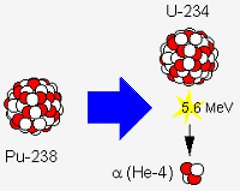
The energetic neutrons are slowed by a moderator, usually water, converting their kinetic energy to heat. The briefly formed uranium-236 is unstable and breaks into lighter nuclei, releasing more neutrons in a chain reaction. Nuclear power derives from the energy released during the fission of a nuclear fuel-typically uranium-235-when it captures neutrons. Today, many governments take the view that, despite the risks, nuclear power offers the fastest, cheapest way to reduce dependence on imported hydrocarbons, cut carbon emissions, and assure energy supply to 2050. Others perceive it to be only an interim solution and one with the inherent risks of accidents and nuclear proliferation. Nuclear power is seen by some as a viable means of generating the electrical power needed to meet future needs.

Ashby, in Materials and the Environment (Second Edition), 2013 12.4 Nuclear power Mars' surface layer represents a tiny fraction of the total volume of the planet yet plays a significant role in the planet's geologic history. The resulting data help scientists understand the planet's mineral composition and the nature of geological processes operating on the surface.

By using characteristics such as color, albedo, and thermal inertia and analytical tools such as reflectance spectroscopy and radar, scientists are able to study the chemistry and physical makeup (e.g., grain sizes, surface roughness, and rock abundances) of the Martian surface. However, it has increasingly become a subdiscipline of geology as automated spacecraft bring ever-improving resolution and instrument capabilities. The study evolved from telescopic and remote-sensing techniques developed by astronomers to study planetary surfaces. The study of surface characteristics (or surface properties and processes) is a broad category of Mars science that examines the nature of the materials making up the Martian surface. 10,37 Minor additions of other elements may either enhance or reduce the susceptibility to ignition 38 (e.g., aluminum or copper, respectively). Alloy additions of molybdenum (5–15%) markedly reduce reaction rates. 36 However, large blocks of metal are not normally liable to selfheating until 400–600 ☌ and then need an external heat source to maintain the situation. The susceptibility of the metal to selfheating increases with the surface area-to-volume ratio of components, and powders may spontaneously ignite at room temperature. In this situation, the supply of oxygen from the air can be rate-determining. The rapid reaction rate, coupled with the large enthalpy or reaction, leads to an appreciable selfheating of specimens and an associated increase in reaction rate.


This gives significantly more rapid oxidation kinetics 35 by comparison with the behavior in carbon dioxide ( Figure 3). The volume change associated with formation of U 3O 8 is greater than for uranium dioxide and, as with carbon dioxide, leads to a linear rate law being established. The lower oxides may also be formed as intermediaries and at lower temperatures. Thermal oxidation of uranium dioxide proceeds in air and results ultimately in the formation of U 3O 8 at temperatures above 200–300 ☌.


 0 kommentar(er)
0 kommentar(er)
